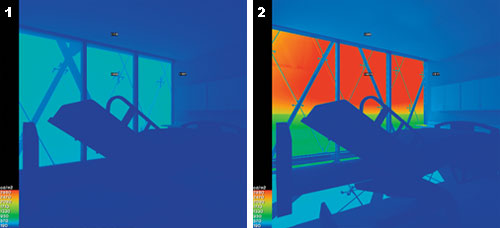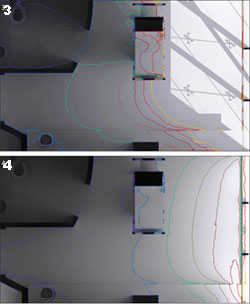Transparency: Literal and Sustainable
Daylighting, glare, and reflectivity
Good thermal performance does not automatically translate into good daylighting performance. Concurrent with its energy studies for the Cleveland Clinic, L+U developed a model with the software Radiance (available for free at http://radsite.lbl.gov) to measure illuminance, or the density of luminous power, across the plan and section of a typical patient room. They also looked at daylight factor (DF), which describes the ratio of outside illuminance to inside illuminance. The calculation is based on an overcast, or "design sky," but designers find it helpful for gauging the performance of a building's envelope, and generally target a DF between 2 and 5 percent.
Ubbelohde says L+U tests mainly for best and worst cases, pinpointing when sunlight becomes too much of a contrast with the room interior and when automatic blinds may be needed to prevent glare. The firm tries to minimize reliance on blinds, according to Ubbelohde, since it can detract from the transparency of the facade. For the clinic, L+U also analyzed the reflectance of the exterior skin to gauge how it will read in full sun and whether it could distract drivers in passing cars.
 |
|
 |
The facade consultants for the Cleveland Clinic project looked at patient-room daylighting conditions with Radiance. As part of this analysis, they examined the effect of various sky conditions at different times of the day and year. Shown here are luminance studies (1, 2) and illuminance studies (3, 4) for March Images courtesy HDR and Loisos + Ubbelohde |
Â
Optimization of characteristics like SHGC, VLT, and reflectance requires not only extensive simulation and careful study, but also a good sensibility for daylighting design, according to Tomasetti's Ng. "You have to understand the psychology of the eye, which sees 50 to 60 percent VLT as transparent," he says. The Chelsea Modern's blue glass has a VLT of 31 percent, but at the vision plane, with the clear glass, it's closer to 70 percent. "An architect has to become engaged in modulating this concept of absolute transparency," he says.









